K-State Laboratory Signs
The Kansas State University Department of Environmental Health and Safety (EH&S) Research and Laboratory Safety Program commissions each campus laboratory or research location through the completion of a laboratory hazard assessment. All laboratories on campus must have a completed and updated hazard assessment on file with EH&S at all times.
Hazard Communication and Laboratory Signage Presentation Video
Completing the hazard assessment form will automatically send a copy to EHS for review and to generate a draft laboratory sign. The Principal Investigator will receive a copy of all laboratory signs (one per room number) to print in COLOR and post.
The hazard assessment form questions can be previewed here before entering the form for your reference.
For any questions, comments, or for assistance with completing this form, please contact EH&S at safety@ksu.edu or 785-532-5856.
Thank you for your partnership and collaboration in campus-wide safety.
Regulatory Requirements
An updated and accurate Hazard Assessment is required for each laboratory by the Kansas Department of Labor (KDOL) through adoption of the Occupational Safety and Health Administration (OSHA) Hazard Communication Standard 1910.1200 and OSHA Personal Protective Equipment Standard 1910.132.
Hazard assessments and laboratory signs provide information that aids workers, informs hazardous materials and emergency response, and facilitates emergency communication. Updated hazard information and signage are two of our most important research safety tools on campus.
Frequency
Laboratories must complete an initial hazard assessment before the initiation of work to commission the laboratory. Laboratories should routinely review the most recent laboratory hazard assessment and make updates with EHS by emailing safety@ksu.edu or completing a new hazard assessment form, when necessary due to change in hazards. It is recommended to review the hazard assessment when you order a new potentially hazardous material (chemical, biological, rad, laser, etc.), when your operations or projects change, and on an annual basis.
**Note: All Kansas State University laboratories must complete and submit an initial hazard assessment to EH&S in 2024 and post new signage in COLOR.**
Posting
A laboratory sign must be posted on each entrance to your laboratory, including on internal doors between rooms. This sign must be posted in COLOR for compliance. Labs may choose to post the sign in a sign holder or binder sleeve for easy decontamination and rotation of signs in the future (if necessary).
Laboratory Sign Possible Hazard Descriptions
The Kansas State University Hazard Communication Program is administered by the Department of Environmental Health and Safety Research and Laboratory Safety Program. The following dropdowns are intended to provide a short overview of possible laboratory sign hazards and language for quick reference in the field.
Defining Laboratory Access - “Access Restricted”
The Laboratory Hazard Assessment asks all laboratory groups to define routine access for each laboratory room on campus.
Most laboratories on campus have access requirements aligned with one of the following options:
- Teaching Laboratory: Access only with Professor or TA approval
- Research Laboratory: Access only with prior PI or Laboratory Manager approval
- Research Laboratory; Access only with prior PI or Laboratory Manager approval and escorted access
- Research Laboratory: Access does not require prior approval
- Clinical/ Diagnostic: Access only with prior PI or Laboratory Manager approval
All individuals accessing laboratories for non-emergency purposes are expected to follow each individual laboratory’s access requirements. Following laboratory access requirements protects individuals (laboratory visitors and laboratory members), supports research and operations integrity, and upholds laboratory security.
Contact information for laboratory access is posted at the top of the sign. The PI is listed first, the laboratory manager or secondary laboratory contact is listed second, and the department safety coordinator is listed third.
Personal Protective Equipment (PPE)
![]()
A PPE Assessment is conducted for each campus laboratory to evaluate potential hazards and provide personnel protection by choosing appropriate PPE for entry and work in the laboratory. All faculty, staff, students, and visitors to the laboratory must wear minimum PPE requirements as indicated on the laboratory sign.
Specialty PPE may be used for specific operations in the laboratory, such as cryogenic gloves for liquid nitrogen work, or bite-scratch gloves for animal work. This specialty PPE must be communicated in laboratory-specific SOPs and work instructions, and in task-specific training for individuals performing these tasks.
Hazard Pictograms
GHS Pictograms – Chemical Hazard Communication
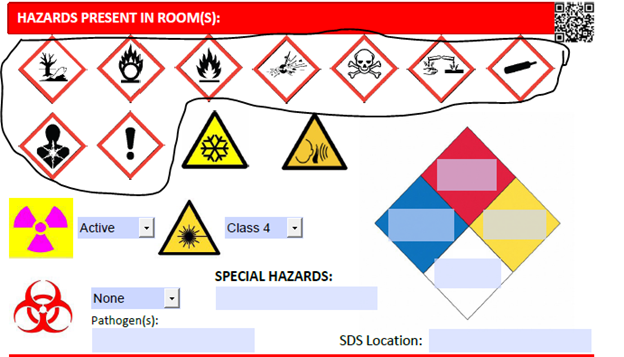
GHS pictograms communicate chemical hazards that may be present across the total chemical inventory of space. These pictograms are outlined in red and have a black image. The following table from the OSHA Hazard Communication Standard QuickCard defines the pictograms:
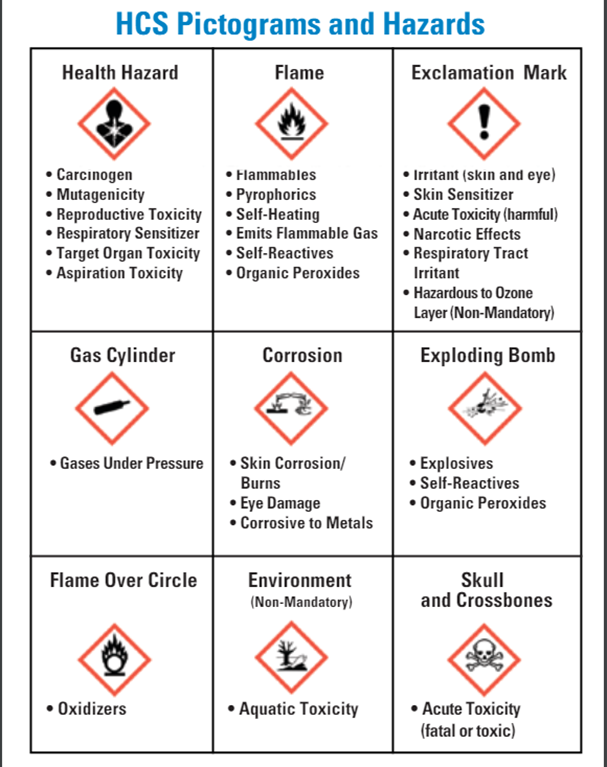
As shown in the table above, single pictograms may represent multiple hazards. Before any work with chemicals, review each chemical safety data sheet (SDS) to ensure you understand the hazards present and recommended protective measures. Any questions about chemicals used or stored in a laboratory space should be referred to the contact information on the laboratory sign.
The SDS location for each laboratory is posted on the laboratory sign under the NFPA diamond.
Cryogen Symbol – Cryogens
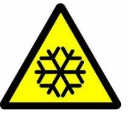
Cryogens are liquids with a normal boiling point below -240°F (-150°C, 123°K). VERY COLD! The most commonly used gases in the liquid state at cryogenic temperatures are argon, helium, hydrogen, nitrogen, and oxygen. Handling of cryogenic materials requires specialty PPE to protect individuals from the cold temperatures of these liquids. Please contact the laboratory at the contact information listed on the laboratory sign if you have questions.
Loud Noise Symbol
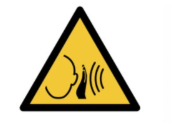
This symbol indicates the potential presence of loud noises (>85 dB) within a space. This can be from many sources, including equipment and animals. Hearing protection may be required in these spaces. Please contact the laboratory using the contact information on the laboratory sign before entry if you are unfamiliar with the noise hazard in the laboratory and if you need hearing protection upon entry.
Trefoil Symbol - Radioactive Hazards
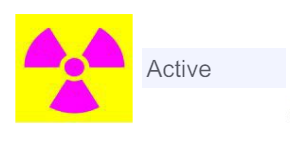
The trefoil symbol indicates the presence of radioactive hazards inside a laboratory space. Radioactive materials should be handled while wearing PPE (lab coat, gloves, safety glasses) and often require shielding approved for the material. Any questions about the radioactive material used in the space should be referred to the contacts listed on the laboratory sign. The Kansas State University Radiation Safety Officer can be contacted at radsafety@ksu.edu or 785-532-5856.
Laser Hazard Symbol – Laser Hazards
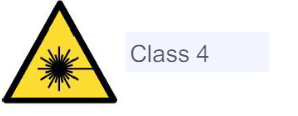
The laser hazard symbol indicates the presence of lasers in the space. The class of lasers is listed on the laboratory sign. Hazards associated with laser classes are described on the table below.
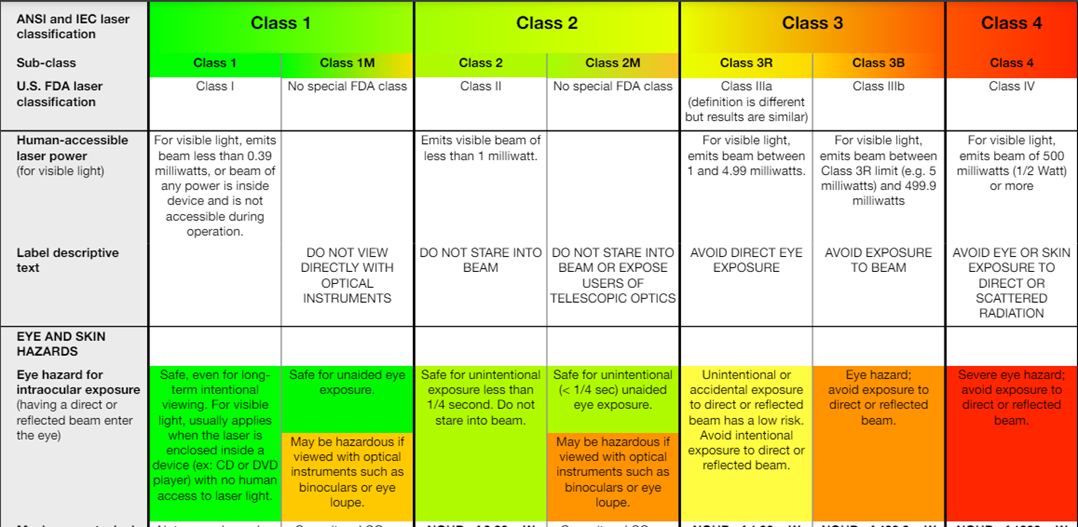
Increasing laser class (output in milliwatts (mW)) results in increasing eye hazard potential.

Always avoid looking directly into laser beams. Shielding and/or eye protection may be required in spaces with lasers during active use. Refer to the laboratory contacts listed at the top of the sign for more information about a laboratory’s specific laser applications. The Kansas State University Laser Safety Officer can be contacted at radsafety@ksu.edu or 785-532-5856.
Images: Laser Safety Facts
Biohazard Symbol – Biological Hazards

The biohazard symbol indicates the presence of biohazardous material in space. The biosafety level is always provided on the laboratory sign. Biosafety levels range from 1-4. The following chart from the NIH briefly describes each biosafety level as it pertains to human health.
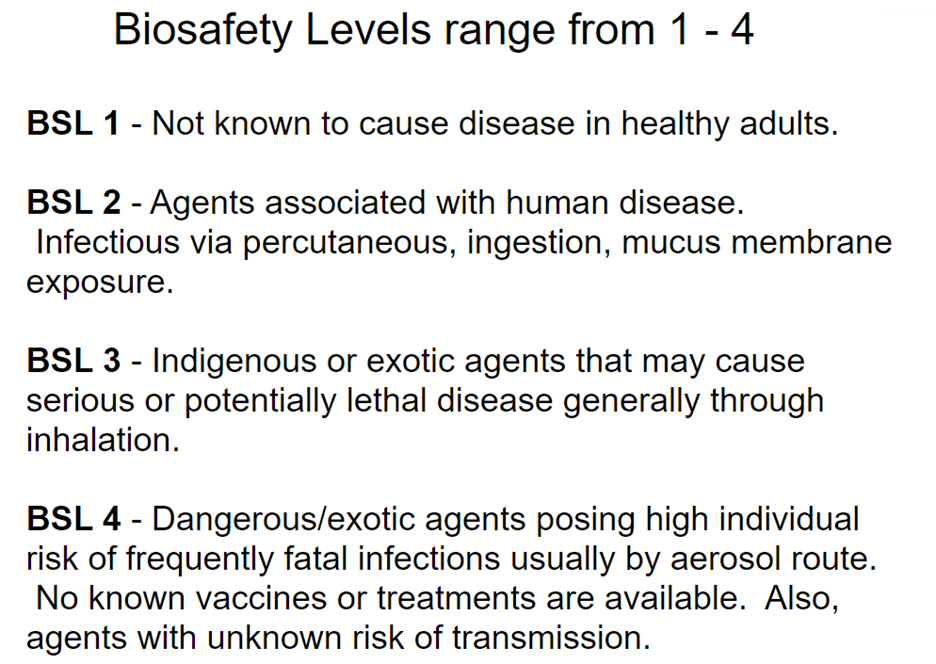
Image: NIH
The pathogen type may be listed on some laboratory signs. Common pathogen types listed may include:
|
Animal Pathogen |
Agent associated with animal disease |
|
Human Pathogen |
Agent associated with human disease |
|
Zoonotic Pathogen |
Agent associated with animal and human disease |
Agent-specific information is omitted from laboratory signs. Questions about specific agents in a laboratory should be directed to the contact information on the laboratory sign.
NFPA 704 Diamond

“The NFPA 704 hazard identification system is characterized by a diamond which is more precisely defined as a “square-on-point” shape. It identifies the degree of severity of the health, flammability, and instability hazards. Hazard severity is indicated by a numerical rating that ranges from zero (0) indicating a minimal hazard, to four (4) indicating a severe hazard. The hazards are arranged spatially such that health hazards are indicated in the nine o’clock position, flammability at the twelve o’clock position, and instability at the three o’clock position. The six o’clock position on the symbol represents special hazards and has a white background; it is not always filled.” (NFPA Hazardous Materials Identification)
Many emergency responders are trained on the NFPA 704 diamond – it helps to facilitate quick decision making in emergency response. The NFPA diamond values and abbreviations on the laboratory sign are representative of the hazards of the laboratory chemical inventory.

Image: NFPA
“Special Hazards”
Special Hazards are hazards or information that do not fall into the pictogram categories above, but that laboratories have indicated should be posted on their laboratory sign. The information included in this section will vary widely across campus laboratories and disciplines. Sometimes, the special hazards section may be used to directly inform emergency responders of additional considerations.
Please contact the laboratory using the contact information listed if you have any questions about this section.
Questions
Questions or Concerns
Lab Specific: Any questions about laboratory sign hazards or language specific to a campus laboratory should be directed to the contacts listed on the laboratory sign.
Hazard Communication Program: General questions about hazards, pictograms, laboratory signs, hazard assessments, or the hazard communication program may be directed to Environmental Health and Safety at safety@ksu.edu or 785-532-5856.
Emergencies
All campus laboratory emergencies should be directed to KSU Police at 785-532-6412.
Helpful Links:
Biosafety in Microbiological and Biomedical Laboratories (BMBL) 6th Edition
OSHA Quick Card - GHS Pictograms and Hazards
OSHA Quick Card - Hazard Communication and Safety Data Sheets (SDSs)